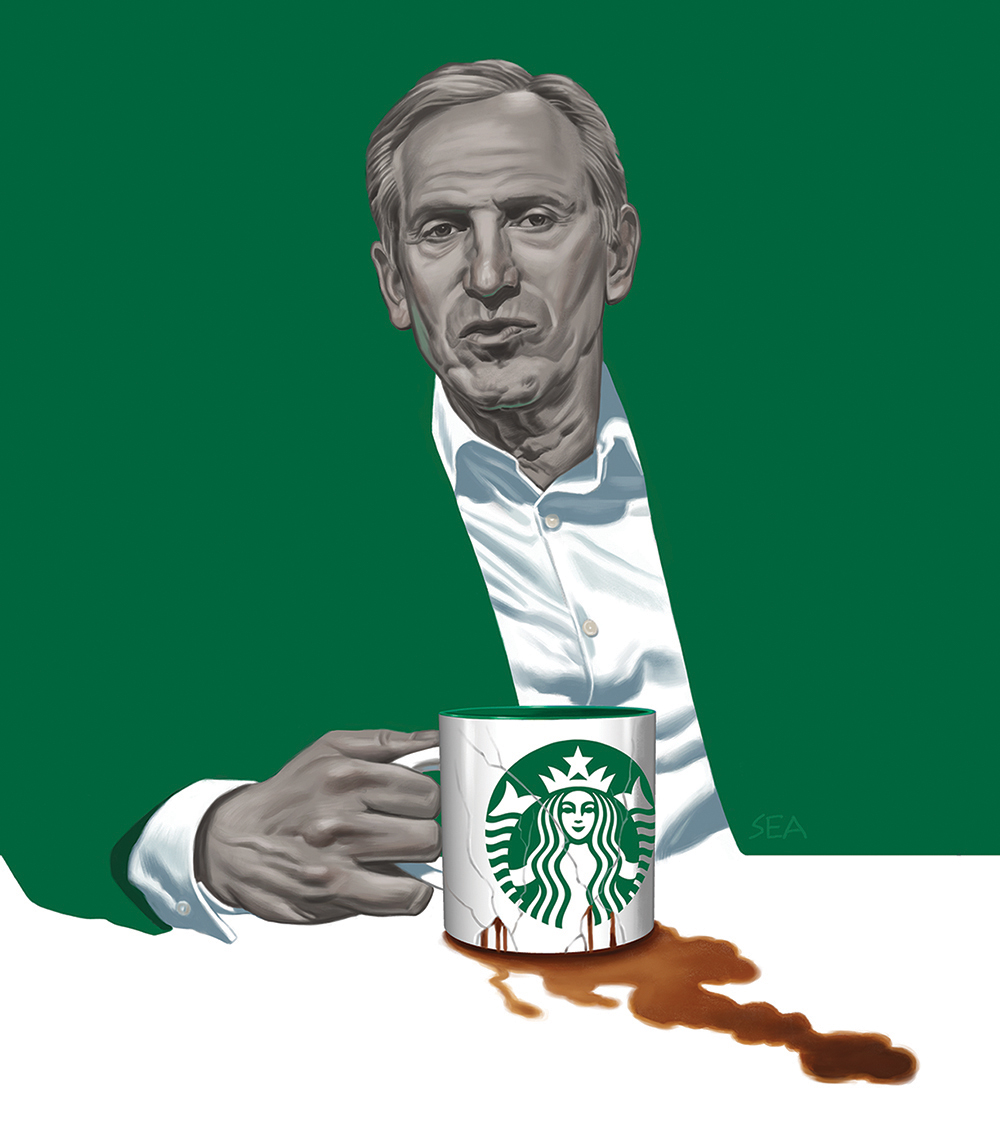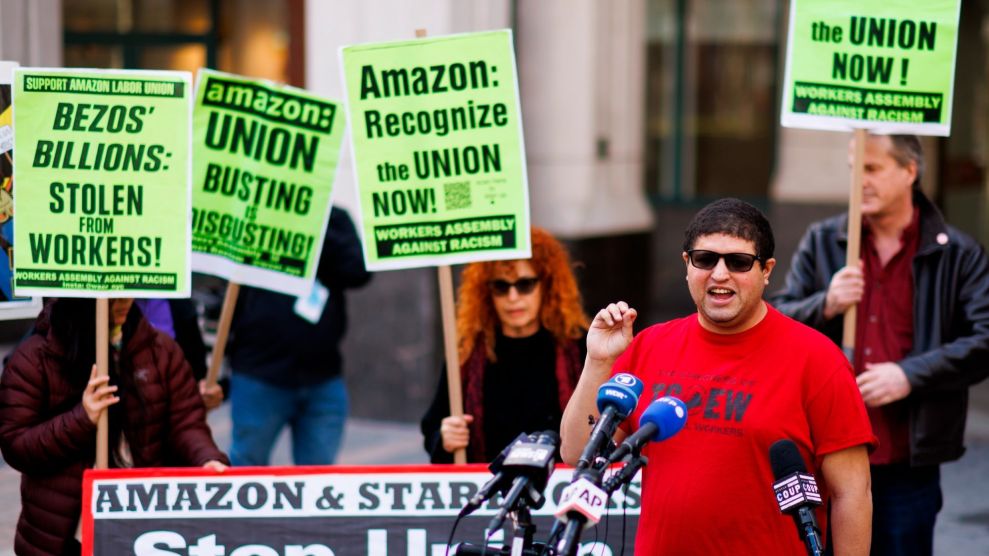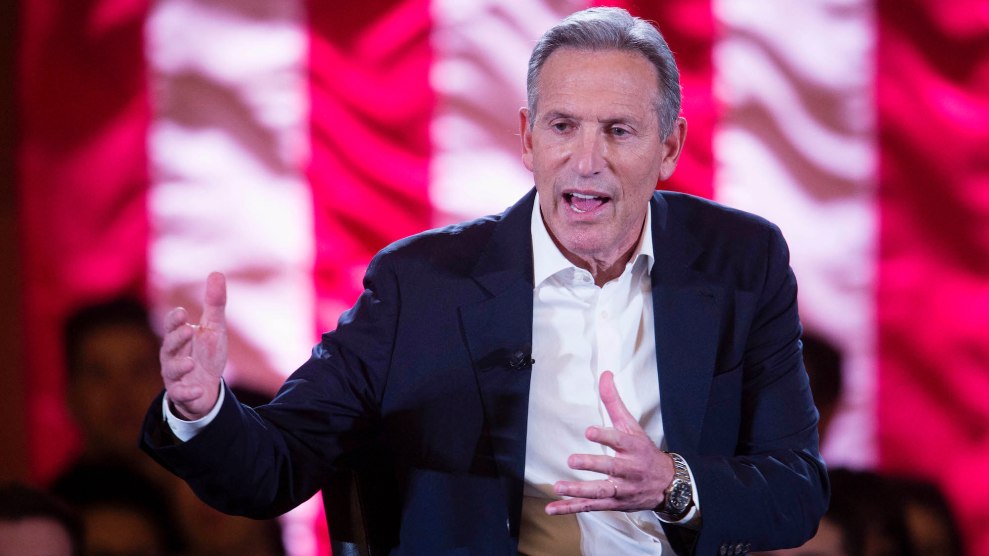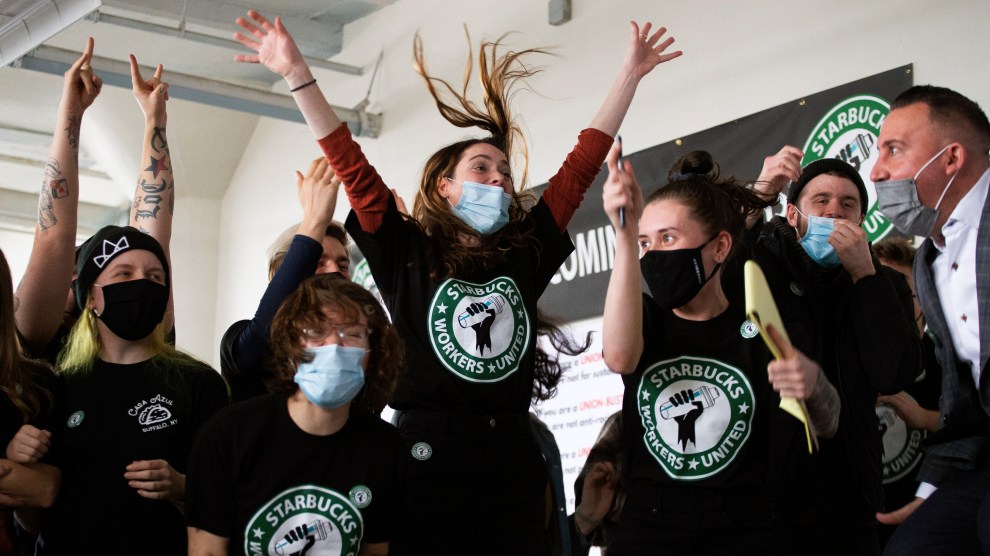In November 2021, Victoria Conklin, a 23-year-old shift supervisor at a Starbucks near Buffalo, was talking to Rossann Williams, then the company’s president of North American retail. Workers at three nearby stores had recently petitioned to become the chain’s only unionized locations in the United States, but Conklin’s hadn’t. Williams wanted to keep it that way.
As the company wrapped up its anti-union campaign, Williams told Conklin that a “special guest” was coming in for a big event. “It’s Howard Schultz,” Conklin responded. “Don’t act like it’s Taylor Swift or something.”
Almost four decades before, Schultz had joined Starbucks as an operations and marketing executive. In 1987, he bought the company for $3.8 million, serving as CEO as it grew into the world’s largest coffee business. Starbucks is now worth more than $110 billion, with more employees than Iceland has people. Schultz stepped down, for the third and final time, in March. With a net worth of nearly $4 billion (including a superyacht worth at least $100 million), he’s not the richest tycoon of his generation, but he is emblematic of its self-satisfied paternalism.
In running Starbucks, Schultz claims he set out to protect people like his blue-collar dad, who was “not respected and dignified and did not have any value.” The threat posed by a union, then, was as much psychic as economic: By organizing, his employees were rejecting the protector who Schultz’s father never had and who Schultz thought he’d become by providing benefits like health care for part-time workers. Organizers’ efforts undermined the good billionaire’s faith in the frictionless existence he thought he’d built, buoyed by global adoration, immense wealth, and the gratitude of the workers who created it.
When Schultz showed up in Buffalo, dressed in a zip cardigan and khakis and flashing his presidential-level veneers, he told the Starbucks workers gathered at a local Hyatt that he would speak from the heart, without notes. In a speech titled “From Buffalo with love,” which Starbucks put on YouTube, Schultz told a well-trod story about how his family was living in public housing in Brooklyn (“better known as the projects”) when he experienced a defining moment of his childhood. In March 1960, his father slipped on ice while delivering cloth diapers. The fall cost him his job and his dignity: The family was forced to accept charity food deliveries. “I experienced, at the age of 7, the imprinting, the shame, the vulnerability, the embarrassment of a family that was really destitute,” Schultz said.
That ordeal was “deeply threaded into every aspect of the foundational values of Starbucks,” he continued. He said it explained the health care for part-time workers, the stock options, and the free tuition at Arizona State. “Who forced us to do it? Who pushed us to do it?” Schultz asked again and again. “No one.”
Schultz told this sob story as part of an effort to stop his workers from joining a union. But his telling ignored how his own family was sustained, especially in this trying period, by the gains of organized labor, in the form of post-war New York’s relatively abundant public housing. The two-bedroom unit the Schultzes called home in Brooklyn’s brand new Bayview Houses, built for families who made too much to qualify for other public housing developments, was the product of a New Deal–era partnership between leftists (many of them in the labor movement) and liberal elected officials who’d embraced their views in the wake of the Great Depression. Schultz and fellow elites have rejected that alliance as they cast unions as relics rendered unnecessary by their personal benevolence. Today, a faded plaque bearing the name of Mayor Robert F. Wagner Jr.—whose father, a senator, helped pass America’s most important piece of labor legislation—is about the only sign that the city was once proud of the complex.
As Schultz began to wrap up at the Hyatt, he veered to a story he’d heard from a rabbi in Israel. Nazis gave just one blanket to every six people sent on rail cars to concentration camps, Schultz recounted, but most victims chose to share them. That story was “threaded” into Starbucks’ essence, too.
After hearing the Holocaust anecdote, Conklin says she wanted to walk out, but decided against making a scene. She was perplexed by a billionaire’s decision to talk about the humiliation of being poor while standing in front of workers the company paid close to the minimum wage.
“I grew up with a single mom and had a fine childhood,” Conklin says. “I would never say the things that Howard has said about his childhood to try and gain sympathy points with people so that they don’t unionize the multibillion-dollar corporation I have. It was just a weird flex.” The next month, workers at one of the three Buffalo locations voted to unionize. Soon after, Conklin told her manager she’d be organizing her store, too.
The victory spurred workers at dozens of Starbucks nationwide to seek elections. The newly formed Starbucks Workers United ended up winning almost all of them in the following months. Richard Bensinger, a former AFL-CIO organizing director who helped craft SWU’s strategy, thought the hardest part was past. He had assumed Schultz would resist unionization at first, but soon back off out of fear of damaging the enlightened-boss image he’d laboriously cultivated. (For his “promotion of responsible capitalism, and advocacy for ethics in business,” in 2016, he accepted a Ripple of Hope Award, alongside Joe Biden, from the human rights organization founded by Ethel Kennedy. Soon after, he was reported to be Hillary Clinton’s top pick for labor secretary.)
But instead, in April 2022, Schultz came out of retirement to personally help stamp out the union drive. Having failed at the soft sell seen in Buffalo, he turned to intimidation.
The company announced it would spend nearly $1 billion on wage increases, benefits, and other worker investment—but only at non-union stores, claiming it was illegal to raise pay for workers under bargaining. It implemented one SWU demand, letting baristas receive tips via credit card—but only at non-union cafes. According to an NLRB court filing, illegal firings of pro-union workers became routine. In one case, seven workers leading a drive at a Memphis store were simultaneously fired; a federal judge later found that to be illegal retaliation and ordered their jobs be offered back. “Even in union campaigns, there’s lines you don’t cross,” Bensinger explained. “They cross them all.” (A Starbucks spokesperson insists such firings are unrelated to unionization, and that the company respects workers’ “right to organize and to engage in lawful union activities.”)
Nevertheless, in June 2022, workers at Conklin’s location voted to unionize. She had worked at the company for five years, but in less than a week, Starbucks fired her, citing that she’d come in late. When she applied for unemployment, Starbucks successfully argued she was ineligible. Conklin won those benefits back on appeal, and also brought a case to the NLRB, which agreed she’d been fired illegally, and has asked an administrative judge to order her reinstatement. For now, she works at Olive Garden.
More than 300 Starbucks stores have had union elections. But as the company assault went on, the pace slowed, and most of the more than 10,200 company-owned stores in the United States remain union-free. Bensinger remains optimistic but knows Schultz’s tactics have had an impact. “The NLRB simply isn’t equipped to deal with somebody like Starbucks. The penalties aren’t there. The speed of action isn’t there. It doesn’t matter who runs the agency,” Bensinger says. “Statutorily, the NLRB doesn’t have the weapons to deter Howard Schultz.” For example, even if Conklin wins her case, Starbucks won’t be fined. The most it could be forced to do is cover backpay and other expenses incurred by Conklin—minus what she’s earned at Olive Garden.
To Conklin, Schultz is an “embarrassingly insecure” man, who, when workers challenged his self-image, responded by harnessing his power to run them over. “The most disgusting thing to me as a fired partner is that he saw his dad and his family struggling when his dad was fired,” she says. “There were months where I had to borrow money from my mom to pay rent. There were months where I had to go over to my friends’ houses to eat. To understand the position that firing somebody unjustly puts people in, and to do it anyway to protect your ego, is so despicable.”
In less than a year, Schultz’s reputation as a can-do corporatist has been replaced by an image as one of this generation’s most committed opponents of unionization. In February, Schultz declined an invitation from Sen. Bernie Sanders (I-Vt.) to appear before his Senate Health, Education, Labor, and Pensions Committee. When Sanders responded by arranging a subpoena vote, Schultz caved and agreed to be grilled by the committee just days before his late March scheduled retirement; on March 20, Starbucks announced Schultz had left early. That made the appearance a fitting last act, if not one he would have chosen.
Bensinger still thinks about a world in which Schultz had a change of heart about busting the union. “If he actually said, ‘I was wrong. I shouldn’t have done this. I got carried away,’ he would be recognized as one of the greatest leaders and businesspeople of all time,” Bensinger says. “But he is not constitutionally capable of that.”












